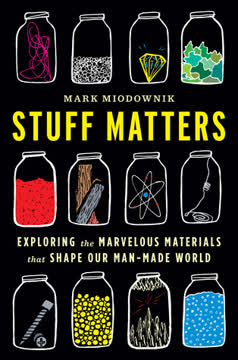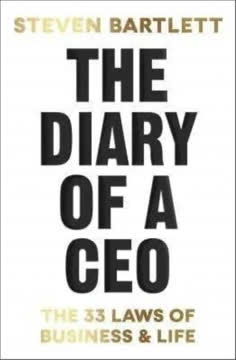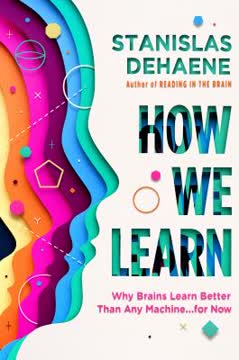Key Takeaways
1. Working Memory is Limited; Learning Requires Chunking
Because the environment is effectively limitless in scope, and our long-term memory is effectively limitless in its capacity, working memory – the only limited component of our memory system – acts as a bottleneck.
Cognitive Bottleneck. Our working memory, the site of conscious thought, can only handle a few pieces of information at once (around 4-7). This limitation is a major constraint on learning. The environment and long-term memory are effectively limitless, but working memory is the bottleneck.
Chunking for Complexity. To overcome this limitation, we "chunk" smaller pieces of information into larger, more meaningful units in long-term memory. This process allows us to think more complex thoughts without overloading working memory. For example:
- Letters combine into words
- Words combine into sentences
- Sentences combine into paragraphs
- Simple math facts combine into complex equations
Automate for Efficiency. Through practice, these chunks become automated, requiring less working memory capacity. This frees up cognitive resources for new learning. New information takes up more working memory capacity than familiar information.
2. Biologically Primary vs. Secondary Knowledge: What to Teach
Biologically secondary knowledge is knowledge we need because our culture has determined that it is important.
Evolved vs. Cultural Knowledge. Biologically primary knowledge, like language and social skills, is acquired naturally and unconsciously. Biologically secondary knowledge, like academic subjects, requires conscious effort and instruction.
Focus on Secondary. Schools primarily teach biologically secondary knowledge, as it's not naturally acquired. Examples include:
- Mathematics
- Science
- History
- Literature
Controversial Claim. The book argues that biologically primary skills are difficult to teach directly, which is a controversial claim. However, the core principles of Cognitive Load Theory remain valid regardless of this distinction.
3. Intrinsic vs. Extraneous Load: Focus on What Matters
In order to increase learning, reduce extraneous load and optimise intrinsic load.
Two Types of Load. Intrinsic cognitive load is the inherent difficulty of the material itself. Extraneous cognitive load is caused by how the material is presented. The goal is to minimize extraneous load and optimize intrinsic load.
Intrinsic Load is Necessary. Intrinsic load is unavoidable if the core concept is to be learned. For example, learning to read requires connecting letters to sounds. This is the cognitive load we want students to engage with.
Extraneous Load is Wasteful. Extraneous load is unnecessary and hinders learning. For example, using distracting images or complex formatting. Reducing extraneous load frees up working memory for intrinsic load.
4. Domain-Specific Knowledge is Key to Expertise
In any biologically secondary area, we can expect the major, possibly sole difference between novices and experts to consist of differential knowledge held in long-term memory.
No Generic Skills. Domain-general skills like problem-solving are not directly teachable. Expertise is domain-specific, meaning it's tied to a particular field.
Experts Have More Knowledge. The primary difference between novices and experts is the amount of relevant domain-specific knowledge stored in long-term memory. Experts have a large collection of situation → action pairs.
Knowledge is Power. To improve problem-solving or critical thinking in a specific area, you must increase your knowledge in that area. Novices use thinking skills, experts use knowledge.
5. Element Interactivity: The Source of Cognitive Load
Element interactivity is the source of all intrinsic and extraneous load.
Interacting Elements. The difficulty of learning material depends on the number of interacting elements that must be processed simultaneously in working memory. More elements and more interactions = higher cognitive load.
Low vs. High Interactivity. Material with low element interactivity can be learned in isolation. Material with high element interactivity requires simultaneous processing. For example:
- Learning a single word is low interactivity
- Finding coordinates on a map is high interactivity
Learner Dependent. Element interactivity depends on both the task and the learner's prior knowledge. Experts experience lower element interactivity than novices.
6. Optimize Intrinsic Load: Pre-teach, Segment, Sequence
Intrinsic load is optimised by good curriculum sequencing.
Adjusting Load. Intrinsic load may need to be increased, decreased, or maintained depending on the situation. The goal is to fully utilize working memory without overloading it.
Pre-teaching Reduces Load. Pre-teaching vocabulary, characters, events, or skills reduces the cognitive load of the main lesson. This allows students to focus on new information. For example:
- Pre-teach key vocabulary before reading a text
- Pre-teach characters before reading a novel
- Pre-teach skills before applying them to new content
Segmentation Breaks Down Complexity. Breaking tasks into smaller, manageable chunks reduces intrinsic load. This can be done by:
- Constructing a skills hierarchy
- Cutting elements from a task
- Sequencing tasks using forward or backward chaining
7. Reduce Extraneous Load: Redundancy, Split-Attention, Transient Info
Extraneous load is minimised by good instructional design.
Minimize Distractions. Extraneous load is anything that distracts from the core learning material. It should be minimized to free up working memory.
Redundancy is Wasteful. Avoid presenting the same information in multiple formats simultaneously (e.g., text and spoken word). Redundant information competes for working memory resources.
Split-Attention Hinders Integration. Place related information close together in space and time. Avoid splitting attention between different sources of information.
Transient Information is Fleeting. Avoid presenting information that disappears quickly. Provide written notes or handouts to reduce the cognitive load of remembering.
8. Modality Effect: Use Visual and Auditory Channels
The modality effect refers to simultaneously presenting related information via both visual and auditory channels, in order to take advantage of this ‘dual channel’ nature of working memory.
Dual Channels. Working memory has separate visual and auditory channels. Using both channels simultaneously can increase learning.
Eliminate Visual Split-Attention. Presenting some information visually and some auditorily can eliminate visual split-attention. For example, show a diagram while explaining it verbally.
Transience Trap. Be careful not to overload the auditory channel with too much information. Provide written notes or handouts for later reference.
Redundancy Trap. Avoid presenting the same information in both written and spoken form simultaneously. The modality effect is not about redundancy, but about using both channels for different types of information.
9. Worked Examples: Structure and Persist
The worked examples are a substitute for the lists of problems that students conventionally are asked to solve after the lesson. They are not a substitute for that lesson presented by the teacher.
Guided Practice. Worked examples are not just models for teaching, but a form of guided practice that students do after the initial lesson. They are a substitute for lists of problems.
Structure for Clarity. Worked examples must be structured to minimize extraneous load. This means taking into account redundancy, transience, split-attention, and modality.
Persist for Mastery. Continue using worked examples until students have a complete understanding of the material. Don't switch to problem-solving too early.
Alternation and Fading. Use example-problem pairs to alternate between worked examples and similar problems. Use fading to gradually remove steps from worked examples.
10. Self-Explanation: Connect Examples to Principles
Students are self-explaining when they explain an example to themselves in terms of its underlying principles, or when they explain to themselves why a particular principle can be applied to a specific example.
Explain to Learn. Students must actively explain worked examples to themselves, connecting them to underlying principles. This helps them see past surface features to the deep structure.
Example-Specific Prompts. Use prompts that encourage students to explain specific steps in a worked example. These can be multiple-choice, fill-in-the-blank, or free-response.
General Prompts. Train students to self-explain spontaneously using general prompts that target process, connection, anticipation, or principles. For example:
- What exactly are you doing?
- How does this new piece of information help?
- How are … and … similar?
- What will happen next?
Self-Explanation is Not Self-Teaching. Self-explanation is not a substitute for explicit instruction. It is a way to connect new examples to previously learned principles.
11. Goal-Free Effect: Focus on Learning, Not Just Answers
CLT shows this is not true.
Goals Can Hinder Learning. Focusing too much on obtaining a specific goal can reduce learning. Students may focus on means-ends analysis rather than understanding the underlying principles.
Remove the Goal. Removing the goal allows students to focus on the process of learning. This can lead to deeper understanding and better transfer.
Restricted Actions, Rapid Feedback, Reliable Results. The goal-free effect works best when students have restricted actions, rapid feedback, and reliable results. Digital learning environments are often ideal for this.
Shift Focus to Understanding. Encourage students to experiment, observe, and understand cause and effect. This approach can lead to better learning outcomes than focusing solely on getting the right answer.
Last updated:
FAQ
What's "Sweller's Cognitive Load Theory in Action" about?
- Overview: "Sweller's Cognitive Load Theory in Action" by Oliver Lovell explores how Cognitive Load Theory (CLT) can be applied in educational settings to enhance teaching and learning.
- Purpose: The book aims to bridge the gap between educational research and classroom practice by providing actionable strategies for teachers.
- Structure: It is divided into three parts: understanding the theory, optimizing intrinsic load, and reducing extraneous load, with practical examples throughout.
- Audience: The book is intended for educators, school leaders, and anyone interested in improving instructional methods based on cognitive science.
Why should I read "Sweller's Cognitive Load Theory in Action"?
- Practical Application: The book offers practical strategies for applying Cognitive Load Theory in the classroom, making it a valuable resource for teachers.
- Research-Based: It is grounded in extensive research and includes insights from John Sweller, the originator of CLT, ensuring the content is both credible and authoritative.
- Improves Teaching: By understanding and applying CLT, educators can enhance their teaching effectiveness and improve student learning outcomes.
- Accessible Language: Oliver Lovell distills complex concepts into understandable language, making the book accessible to educators without a background in cognitive science.
What are the key takeaways of "Sweller's Cognitive Load Theory in Action"?
- Cognitive Architecture: Understanding the limitations of working memory and the role of long-term memory in learning.
- Intrinsic vs. Extraneous Load: The importance of optimizing intrinsic cognitive load and minimizing extraneous load to enhance learning.
- Instructional Strategies: Practical methods such as worked examples, segmentation, and pre-teaching to manage cognitive load.
- Expertise Reversal Effect: Recognizing that instructional strategies may need to change as students become more knowledgeable.
How does Oliver Lovell suggest optimizing intrinsic load in the classroom?
- Pre-Teaching: Introduce key vocabulary and concepts before the main lesson to reduce cognitive load during learning.
- Segmentation: Break complex tasks into smaller, manageable parts to prevent cognitive overload.
- Skills Hierarchy: Develop a hierarchy of skills to ensure foundational knowledge is built before tackling more complex tasks.
- Adjusting Load: Continuously assess and adjust the intrinsic load based on student feedback and performance.
What strategies does "Sweller's Cognitive Load Theory in Action" recommend for reducing extraneous load?
- Eliminate Redundancy: Avoid presenting the same information in multiple formats simultaneously, such as spoken and written.
- Integrate Information: Place related information close together in space and time to reduce the cognitive load of integration.
- Manage Transient Information: Provide written or visual aids to support information that is fleeting or complex.
- Use Dual Modality: Present information using both visual and auditory channels to maximize working memory capacity.
What is the "expertise reversal effect" as discussed in "Sweller's Cognitive Load Theory in Action"?
- Definition: The expertise reversal effect occurs when instructional methods that are effective for novices become less effective as learners gain expertise.
- Implications: Novices benefit from worked examples, while more experienced learners may benefit more from problem-solving practice.
- Instructional Adaptation: Teachers should adapt their instructional strategies based on the learners' level of expertise in a specific domain.
- Dynamic Approach: Recognizing the expertise reversal effect encourages a dynamic approach to teaching, where methods evolve with student progress.
How does Oliver Lovell explain the role of worked examples in learning?
- Definition: Worked examples are step-by-step demonstrations of how to solve a problem, used as a learning tool.
- Benefits: They reduce cognitive load by providing a clear model for students to follow, especially effective for novices.
- Alternation Strategy: Lovell suggests alternating between worked examples and practice problems to reinforce learning.
- Fading Technique: Gradually remove steps from worked examples to encourage independent problem-solving as students gain confidence.
What is the "goal-free effect" and how can it be applied in education?
- Concept: The goal-free effect suggests that removing specific goals can reduce cognitive load and enhance learning by focusing on understanding rather than achieving a set outcome.
- Application: Encourage students to explore and experiment without a fixed goal to promote deeper understanding and transfer of knowledge.
- Pre-Conditions: Effective when actions are restricted, feedback is rapid, and results are reliable, often facilitated by digital learning environments.
- Benefits: Shifts focus from achieving the correct answer to understanding the process, leading to better problem-solving skills.
What are some best quotes from "Sweller's Cognitive Load Theory in Action" and what do they mean?
- "Cognitive Load Theory is a series of instructional recommendations built upon knowledge of how humans learn." This quote encapsulates the essence of CLT as a practical guide for educators based on cognitive science.
- "In order to increase learning, reduce extraneous load and optimize intrinsic load." This highlights the core principle of CLT, emphasizing the need to manage cognitive load for effective learning.
- "The purpose of instruction is to increase the store of knowledge in long-term memory." This underscores the ultimate goal of teaching: to build lasting knowledge that students can draw upon.
- "An excessive focus on goals can lead to students successfully completing a task, but learning very little from it." This warns against the pitfalls of goal-oriented learning, advocating for a focus on understanding and process.
How does "Sweller's Cognitive Load Theory in Action" address the use of technology in learning?
- Digital Environments: The book discusses the use of digital tools to facilitate goal-free learning and provide rapid feedback.
- Simulations: Technology can create simulations that allow students to experiment and understand complex concepts without cognitive overload.
- Self-Management Tools: Lovell suggests using technology to help students manage their own cognitive load, such as through learning apps and software.
- Caveats: While technology can enhance learning, it must be used thoughtfully to avoid introducing extraneous cognitive load.
What future research directions does Oliver Lovell propose in "Sweller's Cognitive Load Theory in Action"?
- Self-Management of Cognitive Load: Investigating how students can be taught to manage their own cognitive load effectively.
- Learner Empowerment: Exploring ways to use CLT to empower students to become more independent learners.
- Technology Integration: Further research into how technology can be used to support cognitive load management in diverse learning environments.
- Biologically Primary Skills: Examining how CLT can be applied to cultivate biologically primary skills, despite challenges in direct teaching.
How can teachers apply the principles of "Sweller's Cognitive Load Theory in Action" in their classrooms?
- Start with Theory: Begin by understanding the cognitive architecture and principles of CLT to inform instructional design.
- Practical Strategies: Implement strategies like worked examples, segmentation, and pre-teaching to manage cognitive load.
- Continuous Assessment: Regularly assess student understanding and adjust instructional methods to optimize learning.
- Professional Development: Engage in ongoing professional development to deepen understanding of CLT and its applications.
Review Summary
Sweller's Cognitive Load Theory in Action receives high praise from readers, with an average rating of 4.50/5. Reviewers commend its clarity, accessibility, and practical applications for educators. Many consider it essential reading for teachers, highlighting its concise explanation of cognitive load theory and its relevance to learning processes. The book is praised for providing actionable strategies and examples across various subjects. Readers appreciate Lovell's ability to distill complex concepts into digestible insights, making it valuable for both experienced educators and those new to the theory.
Similar Books







Download PDF
Download EPUB
.epub digital book format is ideal for reading ebooks on phones, tablets, and e-readers.




